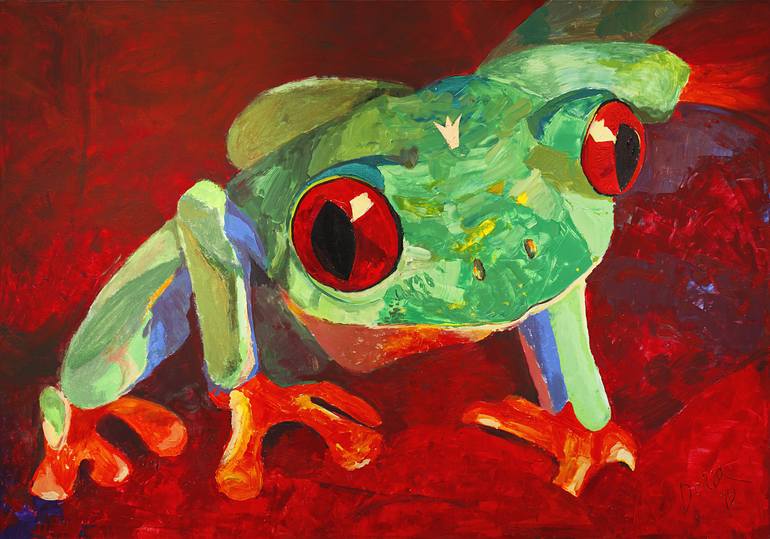





VIEW IN MY ROOM
The Frog Princess Painting
United States
Painting, Acrylic on Canvas
Size: 78.7 W x 55.1 H x 2 D in
Ships in a Tube
Shipping included
14-day satisfaction guarantee
Artist Recognition

Artist featured in a collection
About The Artwork
Painting from 'Wildlife' set by Daria Bagrintseva Agalychnis callidryas (red-eyed tree frog) is an arboreal hylid native to Neotropical rainforests where it ranges from Mexico, through Central America, to Colombia. It is sometimes kept in captivity. The specific name of the red-eyed tree frog, A. callidryas, comes from Greek words kalos (beautiful) and dryas (a tree or wood nymph). As its name suggests, the red-eyed tree frog has red eyes with vertically narrowed pupils. It has a vibrant green body with yellow and blue, vertically striped sides. Its webbed feet and toes are orange or red. The skin on the red-eyed tree frog's belly is soft and fragile, whereas the back is thicker and rougher. Red-eyed tree frogs have sticky pads on their toes. Phyllomedusine tree frogs are arboreal, meaning they spend a majority of their lives in trees; they are excellent jumpers. Red-eyed tree frogs are not poisonous and rely on camouflage to protect themselves. During the day, they remain motionless, cover their blue sides with their back legs, tuck their bright feet under their bellies, and shut their red eyes. Thus, they appear almost completely green, and well hidden among the foliage. The large red eyes not only allow identification, but also serve as a defensive adaptation through deimatic behaviour. When a red-eyed tree frog detects an approaching predator, it abruptly opens its eyes and stares at the predator. The sudden appearance of the red eyes may startle the predator, giving the frog a chance to flee.
Details & Dimensions
Painting:Acrylic on Canvas
Original:One-of-a-kind Artwork
Size:78.7 W x 55.1 H x 2 D in
Frame:Not Framed
Ready to Hang:Not applicable
Packaging:Ships Rolled in a Tube
Shipping & Returns
Delivery Time:Typically 5-7 business days for domestic shipments, 10-14 business days for international shipments.
Handling:Ships rolled in a tube. Artists are responsible for packaging and adhering to Saatchi Art’s packaging guidelines.
Ships From:United States.
Have additional questions?
Please visit our help section or contact us.
United States
Daria Bagrintseva is a world known contemporary artist, winner of 19 international awards in the field of art. Daria's paintings were acquired for the permanent collection of the State Russian Museum in St. Petersburg, Russia. Daria was born in Moscow and is currently based in Miami. A Master of Fine Arts, she studied in Italy, Russia, and the USA. The American magazine ‘Art Business News’ recognized Daria as one of the Top 50 Emerging Artist of the World in 2012. She is the author of the unique methodology of teaching creativity and painting for adults and children. Daria's solo exhibitions took place in more than 20 countries, and she was a Member of Art Basel Art Week in Miami 2012, 2016 and 2019. Daria has also exhibited her work as one of the selected emerging artists in the Louvre, Paris, 2011 and in the castle of Pierre Cardin on the Champs Elysees. In 2016. Her works are in private collections in Russia, USA, Germany, France, Switzerland, Italy, Spain, Norway, Denmark, Holland, Cyprus, and India. Daria has appeared in over 100 printed publications, her paintings found a home in prestigious private collections all over the world, and over 500 of her paintings have been sold. www.dariart.com
Artist Recognition

Artist featured by Saatchi Art in a collection
Thousands Of Five-Star Reviews
We deliver world-class customer service to all of our art buyers.
Global Selection
Explore an unparalleled artwork selection by artists from around the world.
Satisfaction Guaranteed
Our 14-day satisfaction guarantee allows you to buy with confidence.
Support An Artist With Every Purchase
We pay our artists more on every sale than other galleries.
Need More Help?